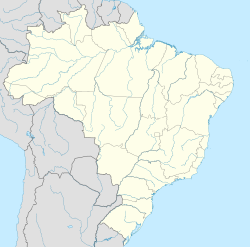world.wikisort.org - Brazil
Vale do Javari (English language: Javari Valley) is one of the largest indigenous territories in Brazil, encompassing 85,444.82 km 2 (32,990 mi 2) – an area larger than Austria. It is named after the Javari River, the most important river of the region, which since 1851 forms the border with Peru. It includes much of the Atalaia do Norte municipality as well as adjacent territories in the western section of Amazonas state. Besides the Javari it is transected by the Pardo, Quixito, Itaquai and Ituí rivers.
Terra Indígena do Vale do Javari | |
|---|---|
Indigenous Territory | |
| Nickname: Vale do Javari | |
 Terra Indígena do Vale do Javari Location in Brazil
= Vale do Javari | |
| Coordinates: 5°21′32″S 70°59′10″W | |
| Country | Brazil |
| State | |
| Area | |
| • Total | 32,990.43 sq mi (85,444.82 km2) |
Inhabitants
Vale do Javari is home to 3,000 indigenous peoples of Brazil with varying degrees of contact, including the Matis, the Matses, the Kulina, and others.[citation needed] The uncontacted indigenous peoples are estimated to be more than 2,000 individuals belonging to at least 14 tribes including the Isolados do Rio Quixito, Isolados do Itaquai (Korubo), Isolados do Jandiatuba, Isolados do Alto Jutai, Isolados do Sao Jose, Isolados do Rio Branco, Isolados do Medio Javari and Isolados do Jaquirana-Amburus.[1] These are believed to be living deep inside its reservation areas. The uncontacted tribes live in some 19 known villages identified by air. According to Fabricio Amorim from Fundação Nacional do Índio, the region contains "the greatest concentration of isolated groups in the Amazon and the world".[1]
The Brazilian government has made it illegal[when?] for non-indigenous people to enter the territory; the area (along with its inhabitants) is observed by the government from the air.[citation needed]
Illegal economic activities
The region is known for being a trafficking route for cocaine.[2] Illegal activities, like fishing (mostly to export pirarucu and piracatinga),[3] logging and mining, help criminal groups linked to drug trafficking to launder money and import more drugs to Brazil.[4][5][6]
In the media
In October 2009, a plane with eleven people aboard emergency-landed in the middle of the reservation. People from the Matis tribe found the wreckage and alerted local authorities, who dispatched a rescue mission that flew nine survivors out of the reservation.[7]
Vale do Javari is the setting of the 2011 report The Unconquered: In Search of the Amazon's Last Uncontacted Tribes by National Geographic writer Scott Wallace. It details a 76-day expedition in 2002 led by Sydney Possuelo to find the status of the "Arrow People", an uncontacted tribe.
In June 2022, British freelance journalist Dom Phillips and Bruno Pereira, a Brazilian expert on indigenous peoples of Amazonas, were murdered for helping to protect indigenous people from illegal drug traffickers, miners, loggers, and hunters.[8]
Notes
- Phillips, Tom (22 June 2011). "Uncontacted tribe found deep in Amazon rainforest". The Guardian. Retrieved 22 June 2011.
- Watson, Katy; Cruz, Jessica (2022-06-13). "Dom Phillips and Bruno Pereira: 'A tragedy foretold'". BBC News. Retrieved 2022-08-17.
- Anjos, Anna Beatriz (2022-06-09). "Vale do Javari teve multa recorde por pesca ilegal de pirarucu". Agência Pública (in Brazilian Portuguese). Retrieved 2022-08-17.
- Spring, Jake; Boadle, Anthony; Spring, Jake (2022-06-19). "Brazil indigenous defender, sidelined under Bolsonaro, gave life for 'abandoned' tribes". Reuters. Retrieved 2022-08-17.
The work of the vigilance team quickly drew attention from local fishermen who sell tons of threatened river fish across the nearby border with Peru. Illegal fishing, mining and poaching in the area is often financed by criminal groups laundering money from a growing cross-border drug trade, according to state and federal police.
- Resende, Leandro. "Estudos mostram relação entre tráfico de drogas e pesca ilegal no Javari". CNN Brasil (in Brazilian Portuguese). Retrieved 2022-08-17.
- Dias Balieiro, Luiz Felipe de Vasconcelos; Nascimento, Izaura Rodrigues (2015-07-06). "Tríplice fronteira Brasil, Peru e Colômbia e as implicações com o narcotráfico". Textos e Debates (26). doi:10.18227/2317-1448ted.v2i26.2789. ISSN 2317-1448.
- "Amazon Indians find plane crash survivors". 30 October 2009. Archived from the original on 6 March 2016.
- Nicas, Jack; Moriyama, Victor (2022-07-11). "Inside the Amazon Journey That Left a Journalist and an Activist Dead". The New York Times. ISSN 0362-4331. Retrieved 2022-07-15.
External links
На других языках
- [en] Vale do Javari
[es] Tierra indígena del Valle del Yavarí
Valle del Yavarí (portugués: Vale do Javari) es una de las tierras indígenas más extensas de Brasil. Está situada en un extremo occidental del estado de Amazonas, cerca de la frontera con Perú. Su nombre proviene del río Yavarí, que es el principal río de la región y que además ha marcado la frontera entre Brasil y Perú desde 1851. Otros ríos importantes de la región son el Quixito, el Itacoai y el Itui.Другой контент может иметь иную лицензию. Перед использованием материалов сайта WikiSort.org внимательно изучите правила лицензирования конкретных элементов наполнения сайта.
WikiSort.org - проект по пересортировке и дополнению контента Википедии